The AMD Llano Notebook Review: Competing in the Mobile Market
by Jarred Walton & Anand Lal Shimpi on June 14, 2011 12:01 AM ESTApplication Performance, Round One: PCMark 7
If the battery life was a pleasant change of pace, general application unfortunately remains a weak spot for AMD. Remember that Llano uses a tweaked K10.5 architecture for the CPU portion of the core, and while L2 cache per core is doubled relative to the previous generation quad-core Phenom parts, clock speeds and IPC (instructions per clock) still appear much lower than what Intel offers. I had hoped to see Turbo Core come into play here, which makes the comparison with Toshiba’s A660D a good starting point. That notebook has a Phenom II X4 P920 (quad-core 1.6GHz) with HD 5650M graphics, so the Llano A8-3500M has very similar specs.
Before we get to the graphs, let me make a quick note that not all laptops have been tested in all applications/games. Most of the systems have been shipped back to the manufacturer, so our newer benchmarks are going to have omissions (e.g. PCMark 7). In the gaming charts later in the review, we’ll have even more omissions, and many of the slower GPUs/IGPs will only be tested at our “low” settings.
With that out of the way, let’s start our application performance comparison with PCMark7, our only all-inclusive benchmark for laptops right now. We’ve run all of the benchmarks suites in the hopes of providing a better look at overall performance; however, outside of the “Computation” suite all of the tests have a storage element. That means any system with an SSD (like the quad-core SNB unit) will boast a massive advantage over the competition. The Computation suite also has an interesting footnote in that it supports Intel’s Quick Sync for video encoding, which again gives SNB systems a massive performance advantage. You can read more about the specific suites in PCMark 7 in their whitepaper. We’ll also have two results for Llano going forward: one for using the fGPU (6620G) and a second for using the dGPU (6630M).
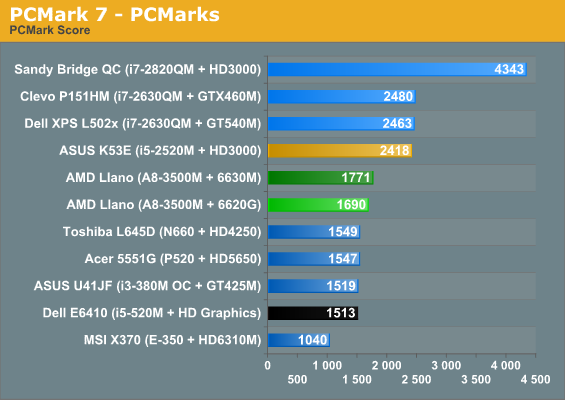
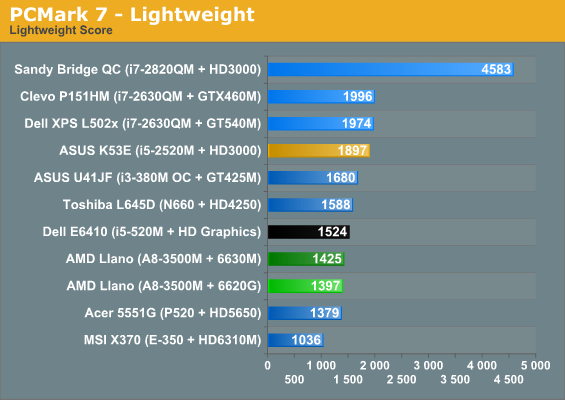
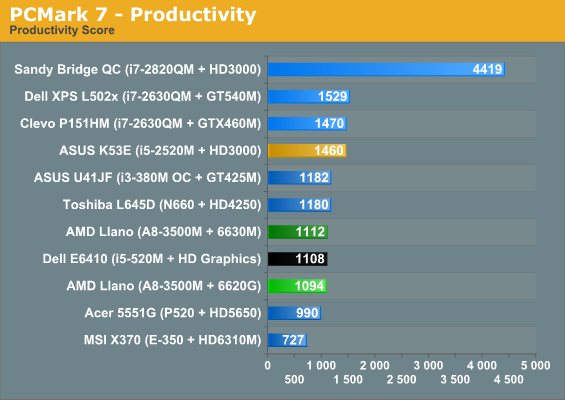
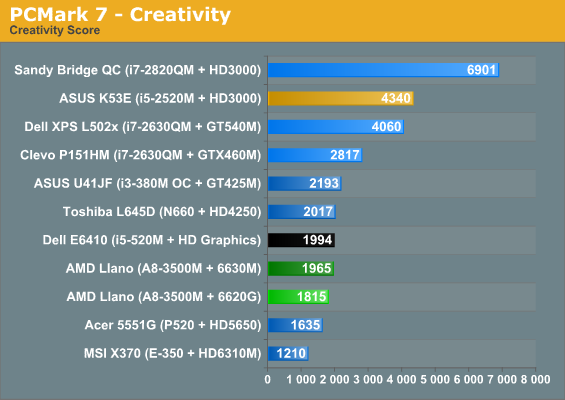
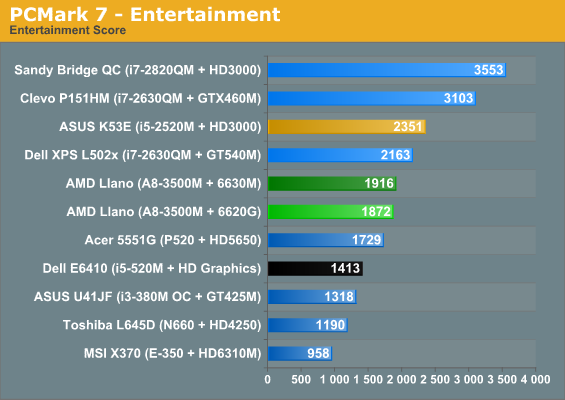

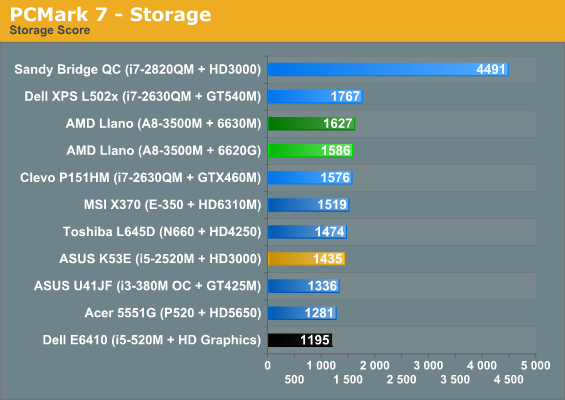
And here’s our first hint that Llano may not be the homerun so many were hoping to see from AMD. All of the SNB laptops are still a healthy step up from Llano in overall PCMarks—the K53E leads by 43%, and systems with quad-core SNB are faster still. Llano might appear to at least surpass the previous generation Arrandale i5-520M in Dell’s E6410, but the storage subsystem in that laptop is a particularly slow 160GB HDD and that skews the results. Then again, the overclocked Arrandale i3-380M in the ASUS U41JF falls short of Llano, so AMD is at the very least competitive with Arrandale.
Since we’re not on a level playing field as far as storage, we won’t comment too much more here, but I do have SSD-based testing complete for four of the notebooks, and once I’ve swapped in an SSD for Llano we’ll have a follow-up article. Let’s move on to application testing round two, where we’ll look at some tests where we eliminate the storage bottleneck.










177 Comments
View All Comments
ionave - Thursday, June 16, 2011 - link
I'm honestly sick of the fact I can't play TF2 on high settings on my laptop AND I cannot find an affordable computer to do so while I'm not paying attention during class. Several people I know feel the same way.krumme - Tuesday, June 14, 2011 - link
The GPU performance hits dues to the shares bus is very low. Getting NV 540 /ati 5650 performance is far better than most expected.Battery life is simply amazing. Far better than expected.
The OEM is standing at a very long line for this.
GeorgeH - Tuesday, June 14, 2011 - link
That battery life is incredibly impressive. That AMD will finally have a competitive mobile offering is huge news; their engineers definitely deserve a pat on the back. Let's just hope that OEMs don't mess things up by cutting costs and shipping Llano laptops with tiny batteries.Unfortunately AMD will almost certainly struggle to get the message across that their CPU performance deficit is pretty much irrelevant for the vast majority of mobile usage models. It'll be especially difficult to get across to the huge number of consumers that think a 2GB 6570 is better than a 768MB GTX 460, but I wish AMD's marketing department the best of luck.
Dribble - Tuesday, June 14, 2011 - link
They'll struggle because cpu performance deficit does matter, cpu performance matters more then gpu performance for most of us. While llano might be *enough* today everyone buys a notebook and expects it too last several years.If llano currently only has the performance of a notebook several years old (core 2 intel) then you can bet in 3 years it'll be dog slow.
Really its only a winner for a pretty small margin of people. If you don't really care about gaming you go intel because cpu's are faster, if you really care about gaming you go intel + discrete. That leaves those who really care about gaming but are on an extremely tight budget.
ET - Tuesday, June 14, 2011 - link
I think that you underestimate the effect of price. If you really care about gaming you go desktop, anyway. If you want a reasonable size laptop with good battery life and capable of some gaming, Llano will fit the bill, and if it sells considerably lower than the competition, then I'm sure a lot of people will buy it. It won't be anyones main gaming rig, but it will surely serve many as a secondary one.I agree that Llano is disappointing at the CPU level, but it really should be enough for most people. How well it sells will depend on pricing. There are big E-350 laptops being sold, which boggles the mind, and there wouldn't be if all people really cared or had any clue about performance.
ppeterka - Tuesday, June 14, 2011 - link
I strongly disagree with you. My first notebook was exceptionally crappy in terms of raw CPU power. Desktop P4 Celeron 2.6GHz was used to power it. Yet I could use it for more than 4 years, after which I changed the CPU to a 2.8GHz P4, only to discover that the "user experience" was left unchanged except of the rare cases when I used the computer to work on it. Compile times were not left unchanged...But even with the Celeron in, the casual usage was just fine. Why? Because of the quite nice VIA IGP in it. I could actually play GTA San Andreas on the poor thing - even though there were times it was not very much fun, but it did work. Swapping the CPU didn't make it much better, only considering work duties.
Today "everything" is about multimedia. By "everything" I mean 80% of what the people are doing. Youtube, Facebook, who-knows-what, all. None of my friends ever regretted heeding to my advice to choose a notebook with a reasonable graphics solution even when there would be an altenative type with a stronger CPU. (of course not to the extremities). Granted, they were not primarily interested in scientific calculations, or heavy duty software development.
Dribble - Tuesday, June 14, 2011 - link
Multimedia doesn't need llano's gpu - SB graphics accelerates video just fine. Hence why you are recommending something that has better 3D graphics performance they'll never use, over something with a faster cpu which they will use all the time?GeorgeH - Tuesday, June 14, 2011 - link
You claim that CPU performance matters. That's true, but can you answer the following -1) Consider two laptops side by side. One has a ~2.5GHz C2D, one has a quad-core Sandy Bridge. Name a single task more than 5% of mobile users run that would allow you to definitively tell which laptop is running the C2D and which has the SB. (Task Manager doesn't count, I'm talking actually using an application.)
2) Name a single task or application that theoretically might let you do the above once it's widespread in the next 3-5 years.
3) What percentage of laptops are sold for <$1000 with roughly Llano or below levels of graphics?
4) What percentage of laptop buyers care about battery life?
My answers are -
1) No clue
2) No clue
3) Most of them
4) Most of them
That's why I say that Llano's battery life is huge and its CPU performance really doesn't matter. Even Intel agrees, which is one reason why you're seeing them move towards lower-power CPUs. Ivy Bridge will have "configurable" TDP, and Haswell will move from 35-35W to 10-20W:
http://www.anandtech.com/show/4378/ivy-bridge-a-ti...
RussianSensation - Tuesday, June 14, 2011 - link
3) The fact is you can get a laptop with better GPU performance and faster CPU performance for $700-750 on the Intel side:i5 480 + HD5730 for $700:
http://www.newegg.com/Product/Product.aspx?Item=N8...
i5 480 + GT 540M (which beat 6620 in almost every gaming benchmark in this review) for $700:
http://www.newegg.com/Product/Product.aspx?Item=N8...
i5 480 + HD6550M for $700:
http://www.newegg.com/Product/Product.aspx?Item=N8...
i5 2410 + GT 540M for $750:
http://www.newegg.com/Product/Product.aspx?Item=N8...
Every single one of these provides faster CPU & GPU performance (http://www.notebookcheck.net/Mobile-Graphics-Cards...
So Llano A-8 would need to be less than $700.
GeorgeH - Tuesday, June 14, 2011 - link
Can you find faster GPUs for <$1000? Sure, but that wasn't the question. Go to Dell or HP's website and look at the number of laptops priced under $1000, then look at the percentage of those that come with significantly better than Llano-level graphics.There's much more to determining the value of a laptop than raw CPU and GPU performance; you could easily pay more than $700 for a Llano laptop and still be getting a very good deal.
I'm not saying whether or not Llano should target this or that price point, though - I'm just trying to give a little perspective.